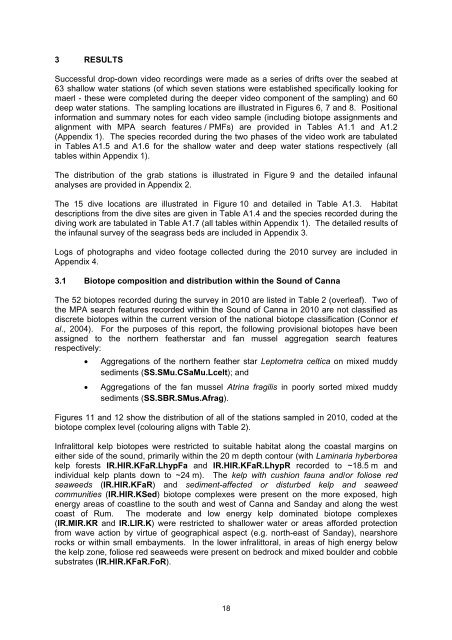Marine biological survey to establish the distribution and status of ...
Marine biological survey to establish the distribution and status of ...
Marine biological survey to establish the distribution and status of ...
Create successful ePaper yourself
Turn your PDF publications into a flip-book with our unique Google optimized e-Paper software.
3 RESULTS<br />
Successful drop-down video recordings were made as a series <strong>of</strong> drifts over <strong>the</strong> seabed at<br />
63 shallow water stations (<strong>of</strong> which seven stations were <strong>establish</strong>ed specifically looking for<br />
maerl - <strong>the</strong>se were completed during <strong>the</strong> deeper video component <strong>of</strong> <strong>the</strong> sampling) <strong>and</strong> 60<br />
deep water stations. The sampling locations are illustrated in Figures 6, 7 <strong>and</strong> 8. Positional<br />
information <strong>and</strong> summary notes for each video sample (including bio<strong>to</strong>pe assignments <strong>and</strong><br />
alignment with MPA search features / PMFs) are provided in Tables A1.1 <strong>and</strong> A1.2<br />
(Appendix 1). The species recorded during <strong>the</strong> two phases <strong>of</strong> <strong>the</strong> video work are tabulated<br />
in Tables A1.5 <strong>and</strong> A1.6 for <strong>the</strong> shallow water <strong>and</strong> deep water stations respectively (all<br />
tables within Appendix 1).<br />
The <strong>distribution</strong> <strong>of</strong> <strong>the</strong> grab stations is illustrated in Figure 9 <strong>and</strong> <strong>the</strong> detailed infaunal<br />
analyses are provided in Appendix 2.<br />
The 15 dive locations are illustrated in Figure 10 <strong>and</strong> detailed in Table A1.3. Habitat<br />
descriptions from <strong>the</strong> dive sites are given in Table A1.4 <strong>and</strong> <strong>the</strong> species recorded during <strong>the</strong><br />
diving work are tabulated in Table A1.7 (all tables within Appendix 1). The detailed results <strong>of</strong><br />
<strong>the</strong> infaunal <strong>survey</strong> <strong>of</strong> <strong>the</strong> seagrass beds are included in Appendix 3.<br />
Logs <strong>of</strong> pho<strong>to</strong>graphs <strong>and</strong> video footage collected during <strong>the</strong> 2010 <strong>survey</strong> are included in<br />
Appendix 4.<br />
3.1 Bio<strong>to</strong>pe composition <strong>and</strong> <strong>distribution</strong> within <strong>the</strong> Sound <strong>of</strong> Canna<br />
The 52 bio<strong>to</strong>pes recorded during <strong>the</strong> <strong>survey</strong> in 2010 are listed in Table 2 (overleaf). Two <strong>of</strong><br />
<strong>the</strong> MPA search features recorded within <strong>the</strong> Sound <strong>of</strong> Canna in 2010 are not classified as<br />
discrete bio<strong>to</strong>pes within <strong>the</strong> current version <strong>of</strong> <strong>the</strong> national bio<strong>to</strong>pe classification (Connor et<br />
al., 2004). For <strong>the</strong> purposes <strong>of</strong> this report, <strong>the</strong> following provisional bio<strong>to</strong>pes have been<br />
assigned <strong>to</strong> <strong>the</strong> nor<strong>the</strong>rn fea<strong>the</strong>rstar <strong>and</strong> fan mussel aggregation search features<br />
respectively:<br />
Aggregations <strong>of</strong> <strong>the</strong> nor<strong>the</strong>rn fea<strong>the</strong>r star Lep<strong>to</strong>metra celtica on mixed muddy<br />
sediments (SS.SMu.CSaMu.Lcelt); <strong>and</strong><br />
<br />
Aggregations <strong>of</strong> <strong>the</strong> fan mussel Atrina fragilis in poorly sorted mixed muddy<br />
sediments (SS.SBR.SMus.Afrag).<br />
Figures 11 <strong>and</strong> 12 show <strong>the</strong> <strong>distribution</strong> <strong>of</strong> all <strong>of</strong> <strong>the</strong> stations sampled in 2010, coded at <strong>the</strong><br />
bio<strong>to</strong>pe complex level (colouring aligns with Table 2).<br />
Infralit<strong>to</strong>ral kelp bio<strong>to</strong>pes were restricted <strong>to</strong> suitable habitat along <strong>the</strong> coastal margins on<br />
ei<strong>the</strong>r side <strong>of</strong> <strong>the</strong> sound, primarily within <strong>the</strong> 20 m depth con<strong>to</strong>ur (with Laminaria hyberborea<br />
kelp forests IR.HIR.KFaR.LhypFa <strong>and</strong> IR.HIR.KFaR.LhypR recorded <strong>to</strong> ~18.5 m <strong>and</strong><br />
individual kelp plants down <strong>to</strong> ~24 m). The kelp with cushion fauna <strong>and</strong>/or foliose red<br />
seaweeds (IR.HIR.KFaR) <strong>and</strong> sediment-affected or disturbed kelp <strong>and</strong> seaweed<br />
communities (IR.HIR.KSed) bio<strong>to</strong>pe complexes were present on <strong>the</strong> more exposed, high<br />
energy areas <strong>of</strong> coastline <strong>to</strong> <strong>the</strong> south <strong>and</strong> west <strong>of</strong> Canna <strong>and</strong> S<strong>and</strong>ay <strong>and</strong> along <strong>the</strong> west<br />
coast <strong>of</strong> Rum. The moderate <strong>and</strong> low energy kelp dominated bio<strong>to</strong>pe complexes<br />
(IR.MIR.KR <strong>and</strong> IR.LIR.K) were restricted <strong>to</strong> shallower water or areas afforded protection<br />
from wave action by virtue <strong>of</strong> geographical aspect (e.g. north-east <strong>of</strong> S<strong>and</strong>ay), nearshore<br />
rocks or within small embayments. In <strong>the</strong> lower infralit<strong>to</strong>ral, in areas <strong>of</strong> high energy below<br />
<strong>the</strong> kelp zone, foliose red seaweeds were present on bedrock <strong>and</strong> mixed boulder <strong>and</strong> cobble<br />
substrates (IR.HIR.KFaR.FoR).<br />
18

















